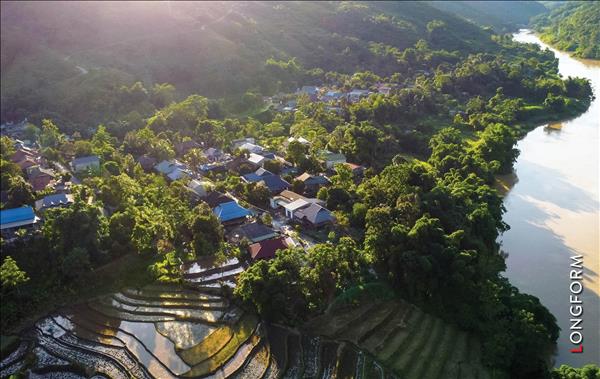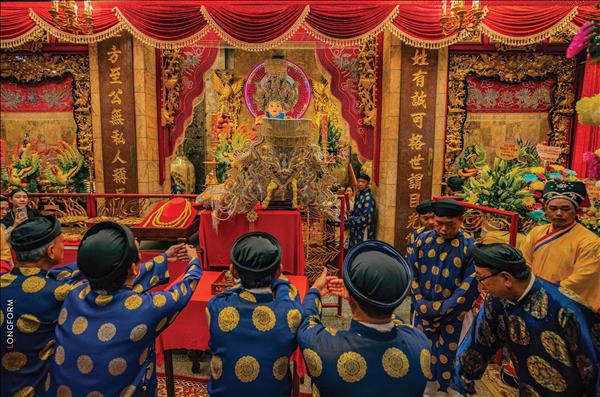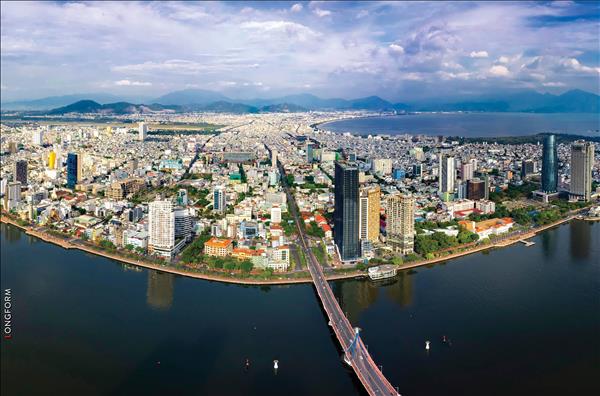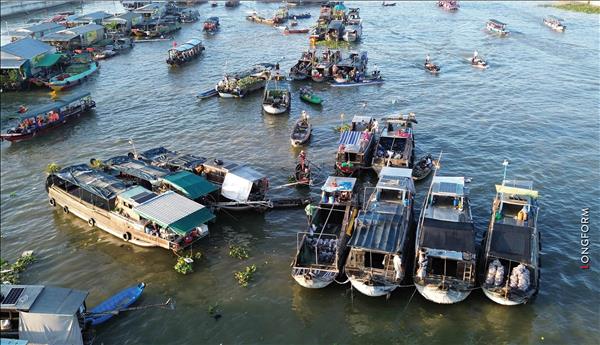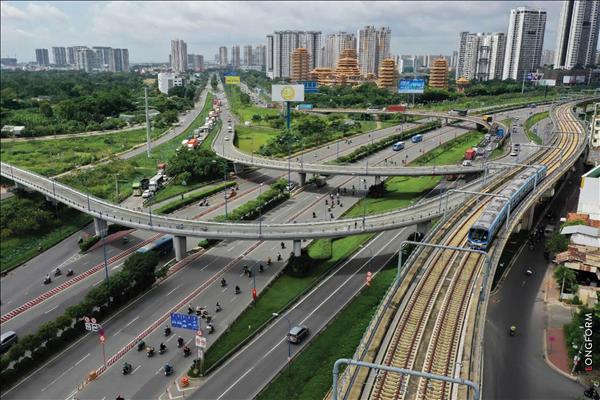Ca Mau is the southernmost province in the country. It is endowed by nature with an abundant source of seafood, vast green forests of cajeputs and mangrove trees, large rivers and pristine beautiful natural scenery. These are the resources that benefit the economic and tourist development of the province.
Exploring Ca Mau Province
From Ca Mau City, we started our journey to discover the southernmost land of the country. Situated in the centre of the city is the imposing Victory Monument which demonstrates the typical strength of the land and people of Ca Mau. We went through calm streets with simple and peaceful houses lying near the banks of the river and visited boat-building workshops and busy markets where many typical specialties of the sea and orchard gardens were sold.
Talking about Ca Mau is to refer to a pristine natural land with immense forests of mangrove and cajuput trees, vast rivers and canals and specific cultural characteristics that no other places have.
Ca Mau has eight rivers that run through the province, forming large estuaries with over 7,000km of rivers and canals, creating the unique beauty of a watery area and diverse culinary specialties. This is a treasure that brings advantages to Ca Mau to develop a tourism industry with specific characteristics.
From Ca Mau City we went towards the western coast and soon reached the Lower U Minh National Park. We climbed to Vong Lam Dai where looking down we saw green mangrove forests in the four directions. The Lower U Minh National Park is considered as a “green lung” of the southwest. It is also the habitation of many species of birds, animals and aquatic creatures. The most attractive thing to visitors to this area is to eat grilled snakehead and follow the local people to go into the mangrove forests to prepare the places for the honey bees to make their nests.
In Tran Van Thoi District, which is not far from the Lower U Minh National Park, there is the Hon Da Bac Tourist Site which is about 180 million years old. This beautiful site looks like a water-colour painting with high mountains mingling with the sea and sky.
We followed the path winding through the rice fields and reached Song Doc Town where boats carrying fish and shrimp are coming in and out throughout the day. Coming to Song Doc, visitors can not only contemplate the vast sea but also learn about the unique cultural feature of the local people, most typically the Lang Ong Nam Hai Festival, a traditional festival of the southernmost coastal residents.
 Ca Mau Province People’s Committte Chairman Pham Thanh Tuoi
« Ca Mau will comprehensively invest in the socio-economic development, change the appearance of the urban and rural areas, give priority to solving unemployment and housing problems and improve the material and spiritual life of its people. »
|
Talking about Ca Mau is to refer to a pristine natural land with immense forests of mangrove and cajuput trees, vast rivers and canals and specific cultural characteristics that no other places have.
Ca Mau has eight rivers that run through the province, forming large estuaries with over 7,000km of rivers and canals, creating the unique beauty of a watery area and diverse culinary specialties. This is a treasure that brings advantages to Ca Mau to develop a tourism industry with specific characteristics.
From Ca Mau City we went towards the western coast and soon reached the Lower U Minh National Park. We climbed to Vong Lam Dai where looking down we saw green mangrove forests in the four directions. The Lower U Minh National Park is considered as a “green lung” of the southwest. It is also the habitation of many species of birds, animals and aquatic creatures. The most attractive thing to visitors to this area is to eat grilled snakehead and follow the local people to go into the mangrove forests to prepare the places for the honey bees to make their nests.
In Tran Van Thoi District, which is not far from the Lower U Minh National Park, there is the Hon Da Bac Tourist Site which is about 180 million years old. This beautiful site looks like a water-colour painting with high mountains mingling with the sea and sky.
We followed the path winding through the rice fields and reached Song Doc Town where boats carrying fish and shrimp are coming in and out throughout the day. Coming to Song Doc, visitors can not only contemplate the vast sea but also learn about the unique cultural feature of the local people, most typically the Lang Ong Nam Hai Festival, a traditional festival of the southernmost coastal residents.
 Ca Mau City is one of the four major urban areas of the Cuu Long River Delta’s economic zone. Photo: Nguyen Luan  Dat Mui estuary in Ca Mau. Photo: Nguyen Luan  The harbor in Ngoc Hien District. Photo: Nguyen Luan  Tourists buy dried seafood products at a market in Ngoc Hien District. Photo: Nguyen Luan  Buying fresh fruit at a market in Ca Mau. Photo: Nguyen Luan  A new residential area in Ca Mau City. Photo: Nguyen Luan  In 2013, Ca Mau received 848,500 domestic and foreign visitors. Photo: Nguyen Luan  The annual Nghinh Ong Festival on the Doc River attracts thousands of locals and tourists. Photo: Du Minh Chien  A view of the Hon Da Bac Tourist Site. Photo: Du Minh Chien  Touring Cape Ca Mau by motorboat. Photo: Nguyen Luan  Ca Mau City by night. Photo: Nguyen Luan |
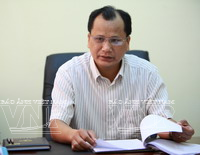 Nguyen Truong Giang, Chairman of Ngoc Hien District People’s Committee, Ca Mau Province «
In the area with high waves and strong wind we must give our minds to the stable economic development, at the same time to the reduction of the difficulties in the people’s life. People in the whole district unite, work hard, always maintain their will to overcome all difficulties and challenges and exploit the potential and advantages to contribute to the construction of their homeland and maintenance of their peaceful life… »
|
Cape Ca Mau with the national landmark and its icon of a ship facing the sea gradually appeared. Cape Ca Mau is the only place on the country’s mainland that sees the sun rising from the East Sea and setting in the western sea.
In the west of the cape there is an alluvial area where the Mam trees (Avicennia) grow and spread, followed by the growth of the mangrove trees with fasciculate roots, making the area expand dozens of meters a year to the sea. While our motorboat was running through the mangrove forests we saw the upright mangrove trees with large roots firmly striking into the ground. We visited the simple houses without door of the fishermen and enjoyed the specialties, such as grilled mudskippers, grilled oysters, shrimp and crabs. We had an unforgettable feeling when we visited this beloved area.
In Ngoc Hien District there are other interesting tourist destinations, such as the Hon Khoai Island, Vam Lung Wharf and the milestone No. 0 on the legendary Ho Chi Minh sea route. In the near future, when the Nam Can Bridge is inaugurated linking Ngoc Hien to the mainland, this area will have opportunities for further socio-economic and tourist development.
The Cape Ca Mau tour has contributed to the development of tourism in Ca Mau. In 2013, Ca Mau received over 800,000 tourists, including over 18,000 foreigners. To better exploit the available tourist potential, Ca Mau should create more tourist products, connect the tourist routes, strengthen the promotion measures and build comfortable accommodation facilities in the main destinations.
Advancing with A “Three-Legged” Position
The natural conditions provide Ca Mau with special advantages for economic development with a strong “three-legged” position which consists of three strong main pillars: fishery – agriculture – forestry (37.1 %), industry (36.9 %) and trade – services (26 %).
The first and also the strongest “leg” in the economic structure of Ca Mau is the fishery – agriculture – forestry, in which the fishery sector accounts for 30% of the provincial GDP. Ca Mau Province has the most developed fishery in the Cuu Long River Delta and has the highest aquaculture area and output in the country. Bordered by the sea on three sides, Ca Mau has a coastline of 254km, the fishing ground covering over 70.000km2 and large saline wetlands, favourable for aquaculture. In 2013, the total output of aquatic products in the province was estimated at 440,000 tonnes; the aquaculture area was 296,000ha in which the shrimp farming area accounted for 90% with over 140,000 tonnes.
To strengthen the fishery sector, the province has invested in developing an offshore fishing fleet of nearly 5,000 boats and building fish wharfs and ports. The businesses in this sector has also focused on the renovation of technologies and equipping their facilities with modern machines.
 The area for raising shrimp accounted for 90% of the province’s total aquaculture area of 296,000ha in 2013. Photo: VNP’file  Oyster farming in the river in Dat Mui Commune, Ngoc Hien District, Ca Mau Province. Photo: Nguyen Luan  Drying fish in a fishing village in Ca Mau Province. Photo: VNP’file  Aquaculture is the key economic sector that accounts for 30% of the province’s GDP. Photo: Nguyen Luan  Ca Mau Fertilizer Plant in the Gas-Power-Fertilizer Complex in Khanh An Commune, U Minh District. Photo: VNP’s file  The automatic packing system in Ca Mau Fertilizer Plant. Photo: VNP’s file  With a capacity of 800,000 tonnes of Urea/year, Ca Mau Fertilizer Plant supplies fertilizer for most of rice growing areas in the Cuu Long River Delta. Photo: VNP’s file  Part of Ca Mau Power Plant No.1. Photo: VNP’s file |
Besides seafood, Ca Mau has over 130,000ha of rice cultivation area which yields more than 560,000 tonnes of paddy a year. In forestry, Ca Mau has a huge carpet of primeval cajuput forests in the Lower U Minh National Park and the world’s second largest mangrove forest, after the Amazon forest, in the coastal wetland of the Cape Ca Mau National Park. In May, 2009 UNESCO recognized the Cape Ca Mau National Park and Lower U Minh National Park as the World Biosphere Reserves. In April, 2013 the Cape Ca Mau National Park was recognized as the 2088th Ramsar site in the world.
The second “leg” in the province’s economy is the industry. In this field, the province has developed its strength in aquatic products processing for export, boat building and repairing, energy and chemical industry. Beside the Ca Mau Gas-Power- Fertilizer Complex which is a national key project, the province also has four industrial zones and four industrial complexes under construction.
Ca Mau City, the capital of Ca Mau Province, is a brilliant point in the industrial picture of the province. It accounts for over 70% of the industrial production value of the province. In the city, there are many large groups and companies engaged in processing the aquatic products. So the stature of one of the four dynamic cities in the economic zone of the Cuu Long River Delta has been gradually confirmed with remarkable achievements in the socio-economic development.
The third “leg” is the trade – services. In this field the province has implemented many promotion measures to help the businesses expand the market and increase exports. Thanks to these efforts the export turnover of the province in 2013 reached over 1,050 million dollars. Aquatic products are the main exported products and have been exported to over 30 countries and territories, such as the United States, Japan and the EU.
With a spirit of efforts, from being a poor province, after 16 years of re-establishment, Ca Mau has become one of the four provinces in the key economic zone in the Cuu Long River Delta. In 2013, the provincial GDP reached over 19 trillion dong, an increase of more than 4.6 times compared to the time of the provincial re-establishment and the income per capita/year was about 1,390 USD, an increase of more than four times.
Talking about the future of the province, Pham Thanh Tuoi, Chairman of the People’s Committee of Ca Mau Province said that the province had built a master plan with a long-term vision, focusing on investing in the development of overall infrastructure, especially in the key projects. In the immediate future, the province would promote the exploitation of the sea economic, forest and tourism potential.
The second “leg” in the province’s economy is the industry. In this field, the province has developed its strength in aquatic products processing for export, boat building and repairing, energy and chemical industry. Beside the Ca Mau Gas-Power- Fertilizer Complex which is a national key project, the province also has four industrial zones and four industrial complexes under construction.
Ca Mau City, the capital of Ca Mau Province, is a brilliant point in the industrial picture of the province. It accounts for over 70% of the industrial production value of the province. In the city, there are many large groups and companies engaged in processing the aquatic products. So the stature of one of the four dynamic cities in the economic zone of the Cuu Long River Delta has been gradually confirmed with remarkable achievements in the socio-economic development.
The third “leg” is the trade – services. In this field the province has implemented many promotion measures to help the businesses expand the market and increase exports. Thanks to these efforts the export turnover of the province in 2013 reached over 1,050 million dollars. Aquatic products are the main exported products and have been exported to over 30 countries and territories, such as the United States, Japan and the EU.
With a spirit of efforts, from being a poor province, after 16 years of re-establishment, Ca Mau has become one of the four provinces in the key economic zone in the Cuu Long River Delta. In 2013, the provincial GDP reached over 19 trillion dong, an increase of more than 4.6 times compared to the time of the provincial re-establishment and the income per capita/year was about 1,390 USD, an increase of more than four times.
Talking about the future of the province, Pham Thanh Tuoi, Chairman of the People’s Committee of Ca Mau Province said that the province had built a master plan with a long-term vision, focusing on investing in the development of overall infrastructure, especially in the key projects. In the immediate future, the province would promote the exploitation of the sea economic, forest and tourism potential.
|
Ca Mau has an area of 5,211km2 and a population of 1,205,000 people (statistics in 2009). According to historical documents, the Vietnamese people have been in Ca Mau since the late 17th century. Previously, Ca Mau belonged to Bac Lieu Province. In 1947 it was separated from Bac Lieu Province and was upgraded to become An Xuyen Province. In 1976 An Xuyen and Bac Lieu Provinces were incorporated into Minh Hai Province. On January 1, 1997, Minh Hai Province was separated into Bac Lieu and Ca Mau Provinces. In 2010, Ca Mau City was recognized as a grade-II city.
|
Story: Van Quy - Photos: Nguyen Luan, Du Minh Chien & VNP’s Files
bdAnh

